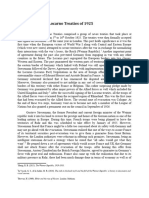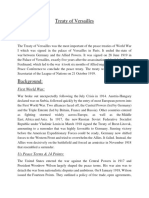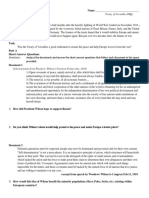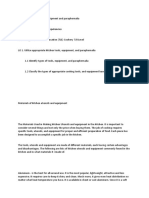Peace of Westphalia
Peace of Westphalia
Uploaded by
Zaigham Sohail JafarCopyright:
Available Formats
Peace of Westphalia
Peace of Westphalia
Uploaded by
Zaigham Sohail JafarOriginal Description:
Copyright
Available Formats
Share this document
Did you find this document useful?
Is this content inappropriate?
Copyright:
Available Formats
Peace of Westphalia
Peace of Westphalia
Uploaded by
Zaigham Sohail JafarCopyright:
Available Formats
Peace of Westphalia
The Peace of Westphalia (German: Westflischer Friede) was a series of peace treaties signed
between May and October 1648 in Osnabrck and Mnster. These treaties ended the Thirty Years'
War (16181648) in the Holy Roman Empire, and theEighty Years' War (15681648)
between Spain and the Dutch Republic, with Spain formally recognizing the independence of the
Dutch Republic.
The Peace of Westphalia involved the Holy Roman Emperor, Ferdinand III; the Kingdom of Spain;
the Kingdom of France; theSwedish Empire; the Dutch Republic; the Princes of the Holy Roman
Empire; and sovereigns of the free imperial cities. The treaties that comprised the peace settlement
were:
The Peace of Mnster[1] between the Dutch Republic and the Kingdom of Spain on 30
January 1648, ratified in Mnster on 15 May 1648; and
Two complementary treaties both signed on 24 October 1648, namely:
The Treaty of Mnster (Instrumentum Pacis Monasteriensis, IPM),[2] between the Holy
Roman Emperor and France and their respective allies.
The Treaty of Osnabrck (Instrumentum Pacis Osnabrugensis, IPO),[3] involving
the Holy Roman Empire, the Kingdom of France, Sweden and their respective allies.
The treaties did not restore peace throughout Europe, but they did create a basis for national selfdetermination.
The Peace of Westphalia established the precedent of peaces established by diplomatic congress,[4]
[5]
and a new system of political order in central Europe, later called Westphalian sovereignty, based
upon the concept of co-existing sovereign states. Inter-state aggression was to be held in check by
a balance of power. A prejudice was established against interference in another nation's domestic
affairs. As European influence spread across the globe, these Westphalian principles, especially the
concept of sovereign states, became central to international law and to the prevailing world order.[6]
............
Treaty of Versailles
From Wikipedia, the free encyclopedia
This article is about the Treaty of Versailles of 28 June 1919, at the end of World War I. For other
uses, see Treaty of Versailles (disambiguation).
Treaty of Versailles
Treaty of Peace between the Allied and
Associated Powers and Germany[1]
Cover of the English version
Signed
28 June 1919[2]
Location
Hall of Mirrors in the Palace of
Versailles in France[3]
Effective
10 January 1920[4]
Condition Ratification by Germany and four Principal
Allied Powers.[1]
Signatori
es
Central Powers
Germany[1]
Allied Powers
United States[1]
British Empire[1]
France[1]
Italy[1]
Japan[1]
Other Allied Powers[show]
Depositar French Government[5]
y
Language French and English[5]
s
Treaty of Versailles at Wikisource
Paris Peace Conference
League of Nations[show]
Treaty of Versailles[show]
Treaty of Saint-Germain-en-Laye[show]
Neuilly-sur-Seine[show]
Treaty of Trianon[show]
Treaty of Svres[show]
The Signing of the Peace Treaty of Versailles
The Treaty of Versailles (French: Trait de Versailles) was one of the peace treaties at the end
of World War I. It ended the state of war between Germany and the Allied Powers. It was signed on
28 June 1919, exactly five years after the assassination of Archduke Franz Ferdinand. The
other Central Powers on the German side of World War I were dealt with in separate treaties.
[6]
Although thearmistice, signed on 11 November 1918, ended the actual fighting, it took six months
of negotiations at the Paris Peace Conferenceto conclude the peace treaty. The treaty was
registered by the Secretariat of the League of Nations on 21 October 1919, and was printed in The
League of Nations Treaty Series.
Of the many provisions in the treaty, one of the most important and controversial required "Germany
[to] accept the responsibility of Germany and her allies for causing all the loss and damage" during
the war (the other members of the Central Powers signed treaties containing similar articles). This
article, Article 231, later became known as the War Guilt clause. The treaty forced Germany to
disarm, make substantial territorial concessions, and pay reparations to certain countries that had
formed the Entente powers. In 1921 the total cost of these reparations was assessed at 132 billion
Marks (then $31.4 billion or 6.6 billion, roughly equivalent to US $442 billion or UK 284 billion in
2015). At the time economists, notably John Maynard Keynes, predicted that the treaty was too
harsh a "Carthaginian peace", and said the reparations figure was excessive and counterproductive, views that, since then, have been the subject of ongoing debate by historians and
economists from several countries.
The result of these competing and sometimes conflicting goals among the victors was a compromise
that left none contented: Germany was neither pacified nor conciliated, nor was it permanently
weakened. The problems that arose from the treaty would lead to the Locarno Treaties, which
improved relations between Germany and the other European Powers, and the re-negotiation of the
reparation system resulting in the Dawes Plan, the Young Plan, and the indefinite postponement of
reparations at the Lausanne Conference of 1932.
You might also like
- ICEL Roman Missal Volume 1a.pdf SafeDocument2,182 pagesICEL Roman Missal Volume 1a.pdf SafeJonathan Peeris100% (1)
- Private Money Presentation 2019Document21 pagesPrivate Money Presentation 2019asegurado100% (3)
- STD-7230 User S ManualDocument28 pagesSTD-7230 User S Manualrifqi sutrisno100% (1)
- History WorkDocument17 pagesHistory WorkSaskiaNo ratings yet
- International Relations, 1919-39Document14 pagesInternational Relations, 1919-39IndrajitChaudhuryNo ratings yet
- Sally Marks German ReparationsDocument26 pagesSally Marks German Reparationsnyphur100% (2)
- People School Workbook PDFDocument172 pagesPeople School Workbook PDFAmr Kamel100% (4)
- Chapter 14 NewDocument4 pagesChapter 14 NewShoaib AhmedNo ratings yet
- History WorkDocument17 pagesHistory WorkSaskiaNo ratings yet
- On The Paris Peace Settlement and Treaty of Versailles - 062154Document3 pagesOn The Paris Peace Settlement and Treaty of Versailles - 062154olaifeajibola28No ratings yet
- Treaty of VersaillesDocument6 pagesTreaty of VersaillesfahadqazifreelancerNo ratings yet
- Significant DatesDocument8 pagesSignificant DatesAri Guevara GuerraNo ratings yet
- World War I Treaties: Joys and Tears : Northwestern UniversityDocument15 pagesWorld War I Treaties: Joys and Tears : Northwestern UniversityMJ HontiverosNo ratings yet
- Tratado de VersallesDocument2 pagesTratado de VersallesIvanrry Arsenio Duran RodríguezNo ratings yet
- Part A Short-Answer Questions: World War 1 & Russian Revolution Treaty of Versailles DBQDocument10 pagesPart A Short-Answer Questions: World War 1 & Russian Revolution Treaty of Versailles DBQSelena ReyesNo ratings yet
- John Maynard KeynesisDocument4 pagesJohn Maynard KeynesisPrasiddha PradhanNo ratings yet
- EssayDocument3 pagesEssayapi-34519736033% (3)
- Obinna 2 AssignmentDocument24 pagesObinna 2 Assignmentnomehnelson626No ratings yet
- Treaty 1Document3 pagesTreaty 1zulqarnainlaadi1No ratings yet
- Core 1 & 2Document12 pagesCore 1 & 21231302136No ratings yet
- Article 231 of The Treaty of VersaillesDocument14 pagesArticle 231 of The Treaty of VersaillesPablo SakakiNo ratings yet
- The Treaty of VersaillesDocument4 pagesThe Treaty of Versailleshaninejrad14No ratings yet
- Treaty of Versailles & Overview of WWIIDocument25 pagesTreaty of Versailles & Overview of WWIInathann6211No ratings yet
- The Paris Peace ConferenceDocument21 pagesThe Paris Peace ConferencekatelinzvitaNo ratings yet
- Notes (Germany)Document23 pagesNotes (Germany)0mara antony GeorgeNo ratings yet
- InterWar Period PDFDocument94 pagesInterWar Period PDFTaimoor Hassan Nambardaar100% (1)
- Paris Peace Conference Group 5Document8 pagesParis Peace Conference Group 5gustavoiscoolayoNo ratings yet
- What Germany Owes GreeceDocument37 pagesWhat Germany Owes Greecepolydeykis1466100% (1)
- WW2 - The Treaty of VersaillesDocument7 pagesWW2 - The Treaty of Versaillesmustakim.rahman26No ratings yet
- To What Extent Could It Be Said That The Treaty of Versailles Did Not Satisfy Any of The 'Big Three' Nations?Document3 pagesTo What Extent Could It Be Said That The Treaty of Versailles Did Not Satisfy Any of The 'Big Three' Nations?nerthus100% (4)
- Dss 807 ProjectDocument19 pagesDss 807 ProjectOjo Favour EbonyNo ratings yet
- The Nuremberg Trials: Volume I: Bringing the Leaders of Nazi Germany to JusticeFrom EverandThe Nuremberg Trials: Volume I: Bringing the Leaders of Nazi Germany to JusticeNo ratings yet
- History of Ir FinalDocument6 pagesHistory of Ir FinalAviral RanaNo ratings yet
- GermanyDocument2 pagesGermanyahmad.rimawi006No ratings yet
- TOV FinalDocument3 pagesTOV Final76153No ratings yet
- History Notes Term 3Document17 pagesHistory Notes Term 3Avril CutinhoNo ratings yet
- World HistoryDocument3 pagesWorld HistoryAnmoool MemonNo ratings yet
- Effects From WWI and the Treaty of Versailles DBQDocument6 pagesEffects From WWI and the Treaty of Versailles DBQsifivi8424No ratings yet
- International Islamic University Islamabad: Submitted To: Sir Nazim Submitted By: Zainab Bashir Subject: World PoliticsDocument9 pagesInternational Islamic University Islamabad: Submitted To: Sir Nazim Submitted By: Zainab Bashir Subject: World PoliticsjamalalawanNo ratings yet
- History Test - Wambwa HerbertDocument11 pagesHistory Test - Wambwa Herbertwambwa herbertNo ratings yet
- The Peace of Westphalia and It Affects On International RelationsDocument8 pagesThe Peace of Westphalia and It Affects On International RelationsAlfina Anam DamayantiNo ratings yet
- Europe Aftre World War One of 1914Document27 pagesEurope Aftre World War One of 1914Mbabazi FaithNo ratings yet
- Treaty of VersaillesDocument42 pagesTreaty of VersaillesPablo SakakiNo ratings yet
- World War I - Part 2Document4 pagesWorld War I - Part 2Muhanad AncondaNo ratings yet
- Golden EraDocument3 pagesGolden EraIndrani GoswamiNo ratings yet
- "The Peacemakers of 1919 - 20 Were Too Short-Sighted To Make A Good Peace Settlement." How Far Do You Agree With This Statement?Document1 page"The Peacemakers of 1919 - 20 Were Too Short-Sighted To Make A Good Peace Settlement." How Far Do You Agree With This Statement?api-3723991No ratings yet
- World History Notes - 2147Document33 pagesWorld History Notes - 2147Muhammad Muhammad100% (2)
- Day1 Context BuilderDocument4 pagesDay1 Context BuilderPhát Hồng PhùngNo ratings yet
- The Versailles SettlementDocument29 pagesThe Versailles SettlementKhan ArishaNo ratings yet
- Paper 1 Revision For IB History HLDocument7 pagesPaper 1 Revision For IB History HLClemNo ratings yet
- The Paris Peace Conference of 1919: The Challenge of a New World OrderFrom EverandThe Paris Peace Conference of 1919: The Challenge of a New World OrderLaurence BadelNo ratings yet
- Hitler's Responsibility For The Second World WarDocument2 pagesHitler's Responsibility For The Second World WarsharmallamaNo ratings yet
- Treaty of VersaillesDocument18 pagesTreaty of Versaillesvenkat kandukuriNo ratings yet
- Practice Questions For Terms of ToVDocument4 pagesPractice Questions For Terms of ToVYahya SalmanNo ratings yet
- Treaty of Versailles Information Sheet 01 12 14Document6 pagesTreaty of Versailles Information Sheet 01 12 14api-276953527No ratings yet
- Hitler Rise To Power DBQDocument10 pagesHitler Rise To Power DBQNicole LongNo ratings yet
- work package treaty of versaillesDocument4 pageswork package treaty of versailles1055172No ratings yet
- Peace TreatiesDocument10 pagesPeace TreatiesAbrîl VGNo ratings yet
- Paris Peace ConferenceDocument15 pagesParis Peace Conferencebaterdene baagiiNo ratings yet
- Was Justice Served at The Paris Peace Conference?: Name BlockDocument7 pagesWas Justice Served at The Paris Peace Conference?: Name BlockKim Seo YeonNo ratings yet
- Compare The Peace of Vienna With The Treaty of VersaillesDocument8 pagesCompare The Peace of Vienna With The Treaty of VersaillesGavin Jose100% (1)
- Isd Cy Team Contact Lists - Saint John To SussexDocument3 pagesIsd Cy Team Contact Lists - Saint John To Sussexapi-313161746No ratings yet
- Agriculture and EnvironmentDocument68 pagesAgriculture and EnvironmentGabriel JamesNo ratings yet
- Tora DocumentationDocument92 pagesTora DocumentationJorge SandalNo ratings yet
- Meru Tantram Edited by Shrinivas Sharma With Commentary of Kapil Dev Narayan, Vol 2, (9-14) - Chaukhamba Sura Bharati Prakashan, VaranasiDocument9 pagesMeru Tantram Edited by Shrinivas Sharma With Commentary of Kapil Dev Narayan, Vol 2, (9-14) - Chaukhamba Sura Bharati Prakashan, Varanasipvihang21No ratings yet
- Antibiotics For Urinary Tract Infections: Nani MaharaniDocument45 pagesAntibiotics For Urinary Tract Infections: Nani MaharaniMelinda FiskaNo ratings yet
- Drink RecipiesDocument12 pagesDrink Recipiestaxsam14No ratings yet
- Crisis Management in the Boeing 737 MAX Crash Incidents (Group 5)Document1 pageCrisis Management in the Boeing 737 MAX Crash Incidents (Group 5)canhuixxxholicNo ratings yet
- Hirohito 2Document13 pagesHirohito 2Aprilia Ayu PurwatiNo ratings yet
- Department of Mechanical Engineering GITAM Institute of Technology GITAM University-VisakhapatnamDocument2 pagesDepartment of Mechanical Engineering GITAM Institute of Technology GITAM University-VisakhapatnamYeditha Satyanarayana MurthyNo ratings yet
- M 1 - Grammar...Document10 pagesM 1 - Grammar...Rania singerNo ratings yet
- SB Tbo Pt6a-65agDocument30 pagesSB Tbo Pt6a-65agturbotechagricolaNo ratings yet
- Shanmuganathan Engineering College: ARASAMPATTI - 622 507Document3 pagesShanmuganathan Engineering College: ARASAMPATTI - 622 507BALAKRISHNANNo ratings yet
- Chapter 7 - Government Policy and International TradeDocument36 pagesChapter 7 - Government Policy and International Trade7hdz5v4chpNo ratings yet
- Idioms SlangsDocument6 pagesIdioms SlangsTeacher 1No ratings yet
- CV - Zeynep MadenDocument2 pagesCV - Zeynep MadenzeynepNo ratings yet
- Guide To Education Costs in Canada To 2037Document1 pageGuide To Education Costs in Canada To 2037Daniel ConnoryNo ratings yet
- Shiraz Arts FestivalDocument6 pagesShiraz Arts FestivalAngel ColeNo ratings yet
- Field Visit Report: Samohita Das Bsc-15-34 BSC Psychology 3 Year Psychopathology-Ii MSSWDocument10 pagesField Visit Report: Samohita Das Bsc-15-34 BSC Psychology 3 Year Psychopathology-Ii MSSWpreethikaNo ratings yet
- Area ChartDocument3 pagesArea Chartjatin bishtNo ratings yet
- FTGA Volume 2Document235 pagesFTGA Volume 2Garden Club of VirginiaNo ratings yet
- Tribebook: CroatoanDocument10 pagesTribebook: CroatoanGnomeMadeIon100% (5)
- Utilize Kitchen Tools and Equipment and ParaphernaliaDocument12 pagesUtilize Kitchen Tools and Equipment and ParaphernaliaAimee SiocoNo ratings yet
- The Graduates 2Document15 pagesThe Graduates 2Maam Elle CruzNo ratings yet
- Incoterms 2020 Rules Chart of Responsibility: Any Transport Mode Sea/Inland Waterway Transport Any Transport ModeDocument2 pagesIncoterms 2020 Rules Chart of Responsibility: Any Transport Mode Sea/Inland Waterway Transport Any Transport ModeRicardo PirelaNo ratings yet
- Regarding Group B Selection IN PLWDocument36 pagesRegarding Group B Selection IN PLWmoviesprostudioNo ratings yet
- Chapter 2 - (Lesson 4 & 5 - Activity)Document5 pagesChapter 2 - (Lesson 4 & 5 - Activity)Plain KitchenNo ratings yet

























































































